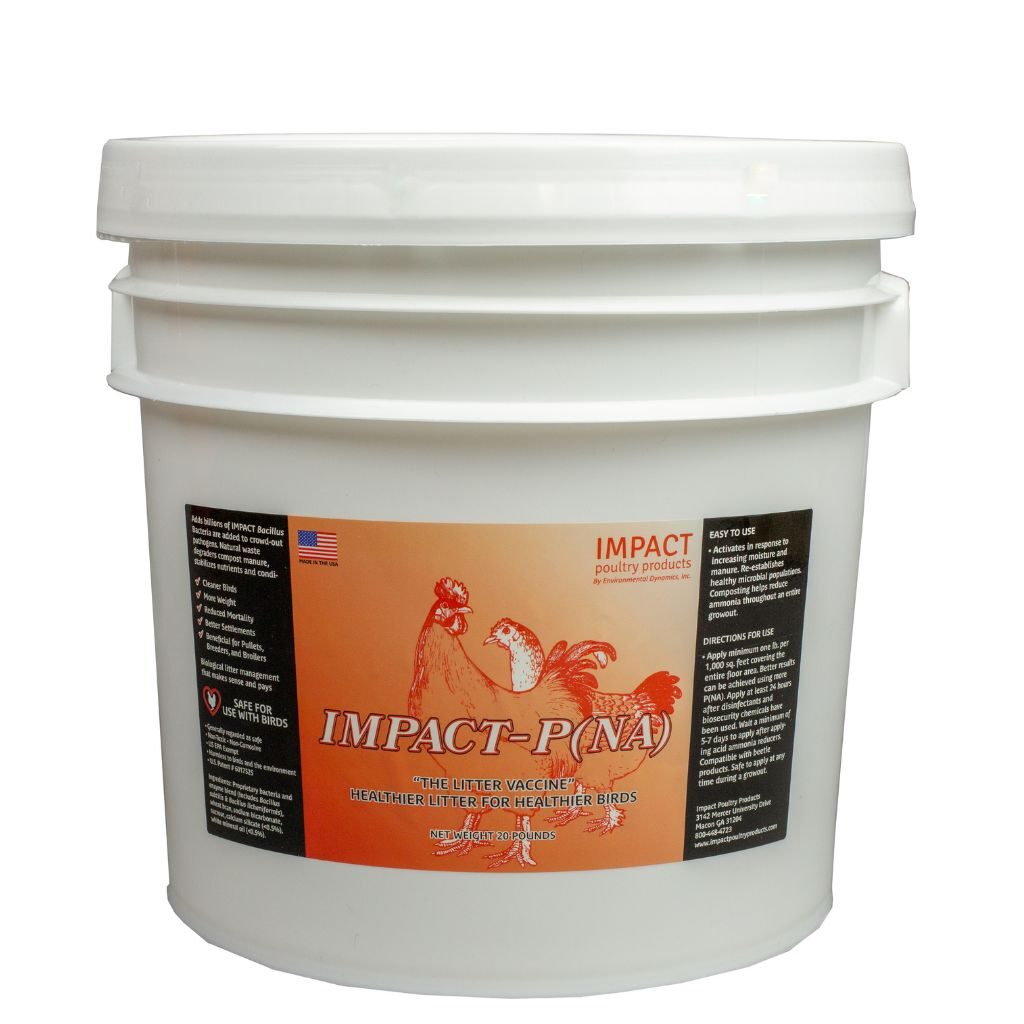IMPACT-P(NA)
Biological Litter Amendment

Overwhelm and Out-Compete Pathogens
Huge numbers of laboratory-grown, beneficial bacteria overwhelm and out-compete pathogens that can cause disease outbreaks in your flock.
Lower Ammonia Levels
A patented blend of bacteria and enzymes efficiently composts poultry waste resulting in lower ammonia levels and a healthier growing environment for your flock’s entire growout.
Continuously Dry, Compost, Improve the Litter
Vast numbers of highly efficient composting bacteria do what they do best … continuously dry, compost, and improve your litter with each flock.
Easy and Safe To Use
Quick and easy to apply with a seed broadcaster; non-toxic and safe to apply with birds in the house; non-corrosive; good to use within days of litter acidifiers.
IMPACT-P(NA): Advanced Biological Litter Amendment for Poultry
What is IMPACT-P(NA)?
IMPACT-P(NA) is a revolutionary “need activated” biological litter amendment. This poultry litter treatment contains nearly one billion beneficial bacteria per square foot. Apply IMPACT-P(NA) before each flock to transform your litter management system.
The product introduces massive populations of beneficial Bacillus bacteria to poultry litter. These waste-degrading bacteria activate automatically as flock conditions change. IMPACT-P(NA) bacteria grow when moisture, heat, and nutrients increase during growout.
Key Benefits of IMPACT-P(NA) Litter Treatment
Reduces Ammonia Levels by 50%
IMPACT-P(NA) bacteria are highly efficient waste degraders. These specialized bacteria decompose poultry waste more effectively than natural microbes. Efficient waste decomposition reduces ammonia production significantly. IMPACT-P(NA) can reduce ammonia levels by up to 50% throughout the entire growout period.
Controls Disease-Causing Bacteria
IMPACT-P(NA) bacteria outcompete harmful pathogens in poultry litter. The product controls dangerous bacteria like Salmonella, E. coli, Pasteurella, and Clostridium. Disease-causing bacteria thrive on nutrients, moisture, and heat in litter. IMPACT-P(NA) dominates the litter microbiome with beneficial bacteria instead of harmful microbes.
Improves Litter Quality Through Natural Composting
IMPACT-P(NA) bacteria continuously compost litter in place. This composting action dries out wet litter naturally. Reduced moisture eliminates conditions that disease-causing bacteria need to survive. The composting process maintains a healthy litter microbiome dominated by beneficial bacteria.
Extends Litter Lifespan
IMPACT-P(NA) continuously improves litter quality, allowing properly treated litter to be safely reused flock after flock. This saves time and money during resting periods. Litter reuse reduces operational costs and waste disposal expenses.
Simple IMPACT-P(NA) Application Process – Maximum Poultry Litter Results
Perfect Timing for Peak Poultry Litter Performance
Apply IMPACT-P(NA) biological litter amendment after decaking, stripping, windrowing, or adding fresh litter top-coat for maximum impact. Wait 5-7 days after using acid ammonia reduction chemicals to apply the product. Low pH conditions neutralize beneficial bacteria before they can improve poultry litter quality.
Proven IMPACT-P(NA) Application Method That Works
Use just 1 lb per 1,000 square feet of poultry house floor space. One convenient 20 lb pail treats 20,000 square feet of poultry operation space. Apply IMPACT-P(NA) biological litter treatment as early as possible to maximize your return on investment.
Easy to Apply
Apply with any seed spreader or broadcast spreader for perfect poultry litter distribution. Walk a strategic horseshoe pattern around outside drinker lines first. Make your second pass around inside drinker lines for complete poultry litter coverage. This ensures total house coverage with concentrated protection in high-nutrient zones where poultry litter problems start.
Total Safety and Compatibility Guarantee for Poultry Operations
IMPACT-P(NA) biological litter amendment is completely non-toxic and non-corrosive – safe for your birds, your workers, and your poultry operation. Apply confidently at any time before or after bird placement (but at least 5-7 days after litter acidifiers are used). The poultry litter treatment integrates seamlessly with beetle control products and vaccines. IMPACT-P(NA) works during growout but delivers maximum poultry litter results when deployed early.
Transform Your Poultry Operation with IMPACT-P(NA) Biological Litter Treatment
Stop accepting mediocre poultry litter performance. IMPACT-P(NA) offers the natural poultry litter solution that serious poultry operators demand. This biological powerhouse eliminates harmful bacteria while maximizing poultry litter quality and profitability.
Experience reduced ammonia in poultry litter, healthier birds, and extended litter life with every application. Easy deployment makes IMPACT-P(NA) the smart choice for poultry operations ready to dominate their market. Your competition wishes they had this poultry litter management advantage.